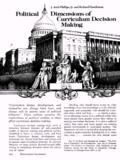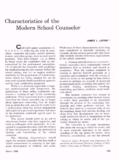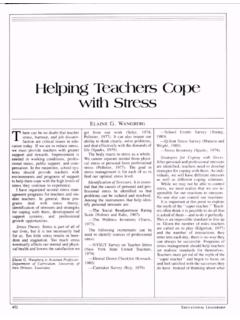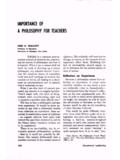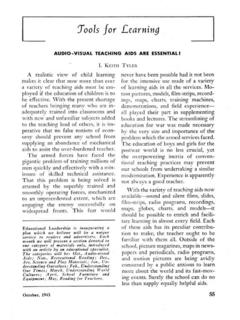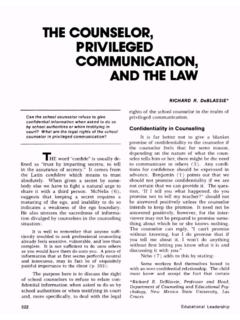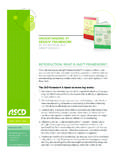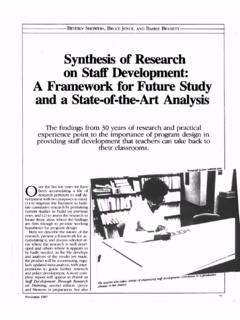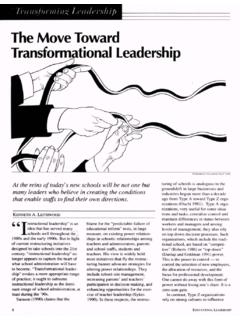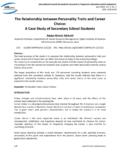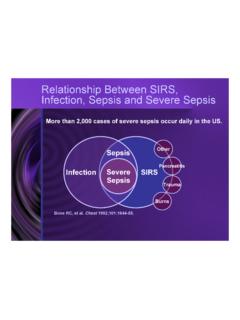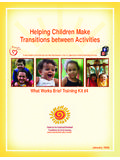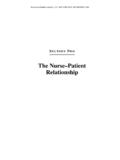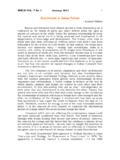Transcription of The Structural Approach to Cooperative Learning
1 SPENCER KAGANq =p ~ =^ ~ = =` ~ =i ~ Teachers who are well versed in a variety of teamstructures can create skillful lessons that engageand enlighten their Structural Approach to coop erative Learning is based on the creation, analysis, and system atic application of s I= r con tent-free ways of organizing social in teraction in the classroom Structures usually involve a series of steps, with proscribed behavior at each step. An important cornerstone of the ap proach is the distinction between "structures" and "activities."To illustrate, teachers can design many excellent Cooperative a I=such as making a team mural or a quilt Such activities almost always have a specific content-bound objective and, thus, cannot be used to deliver a range of academic content.
2 In contrast, s = = ay be used repeatedly with almost any subject matter, at a wide range of grade levels, and at various points in a lesson plan. To illustrate further, if a teacher new to Cooperative Learning learns five activities, he or she might well report back after a week, "Those worked well, but what should I do next week?" If, instead, the teacher learns five structures, he or she could meaningfully include Cooperative Learning in lessons all year to further the academic progress of students in any subject matterp = = = = = = =~ ~ I= I=~ = ~ = ~ I=~ = =~ = = = = = = = =~= = ~ KAccordingly, structures can be com bined to form "multistructural" les sons in which each structure or building block provides a Learning experience upon which subsequent structures expand, leading toward pre determined academic, cognitive.
3 And social objectives` = K=` ~ =p In teaching, new structures continue to be developed, and old structures continue to evolve. They are based on distinct philosophies of education andlead to variations in types of Learning and cooperation, student roles and communication patterns, teacher roles, and evaluation (Kagan 1985). There are several dozen distinct struc tures, some with adaptations, such as the half dozen major variations on Jigsaw (Kagan 1989) Among the most well-known structures are Jigsaw (Aronson et al 1978); Student-Teams Achievement-Divisions, or STAD (Slavin 1980); Think-Pair-Share (Ly- man 1987).
4 And Group-Investigation (Sharan and Hertz-Lazarowitz 1980)One of the most common struc tures teachers use is a competitive structure called Whole-Class Ques tion-Answer (see fig 1) In this ar rangement, students vie for the teach er's attention and praise, creating negative interdependence among them That is, when the teacher callsFig. 1. Whole-Class Question-Answer1. The teacher asks a Students who wish to respond raise their The leacher calls on one The student attempts to state the correctNOEDUCATIONAL NuKb Together1. Tlie teacher has students number off within groups, so that each student has a number: 1, 2, 3, or The teacher asks a The teacher tells the students to "put their heads together to make sure that everyone on the team knows Ihe The teacher calls a number (1, 2 , 3, or 4), and students with that number can raise their hands to one student, the others lose their chance to answer, a failure by one student to give a correct response increases the chances for other.
5 Stu dents to receive attention and praise Thus, students are set against each other, creating poor social relations and peer norms against achievement. In contrast to the competitive Whole-Class Question-Answer struc ture stands Numbered Heads To gether, a simple four-step Cooperative structure (see fig. 2). Numbered Heads includes teams, positive inter dependence, and individual account ability, all of which lead to Cooperative interaction among students Positive interdependence is built into the structure: if any student knows the answer, the ability of each studept is increased. Individual accountability is also built in: all the helping is confined to the heads together step; students know that once a number is called, each student is on his or her own.
6 The high achievers share answers because they know their number might not be called, and they want their team to do well. The lower achievers listen care fully because they know their number might be called Numbered Heads. To gether is quite a contrast to Whole- Class Question-Answer in which only the high achievers need participate and the low achievers can (and often do) tune outt =p =j~ =p \As I mentioned, there are a number of different structures, as well as varia tions among them This variety is nec essary because the structures have dif ferent functions or domains of illustrate, let's contrast two simi lar simple structures, Group Discus sion and Three-Step Interview (see fig.)
7 3) In Group Discussion, there is no individual accountability; in some groups some individuals may partici pate little or not at all Also, there is no assurance that team members will lis ten to each other: in some groups all the individuals may be talking while none are listening. Further, at any one moment, if one person at a time is speaking, one-fourth of the class is involved in language contrast, in Three-Step Interview, each person must produce and re ceive language; there is equal partici pation; there is individual accountabil ity for listening, because in the third step each student shares what he or she has heard; and for the first two steps, students interact in pairs, so one-half rather than one-fourth of the class is involved in language produc tion at any one , there are profound differ ences between apparently similar sim ple Cooperative structures.
8 Group Dis cussion is the structure of choice for brainstorming and for reaching group consensus; Three-Step Interview is far better for developing language and listening skills as well as promoting equal participation. When the teacher is aware of the effects of different structures, he or she can design les sons with predetermined to more complex structures, the differences are even greater. For example. Co-op Co-op (Kagan 1985a) is a 10-step structure in which students in teams produce a project that fosters the Learning of students in other teams. Each student has his or her mini-topic, and each team makes a distinct contri bution toward the class goal.
9 The struc ture involves higher-level thinking skills, including analysis and synthesis of ma terials like all structures, however. Co-op Co-op is content-free. For exam ple, when it is used in university class rooms, students may work 10 weeks to complete a sophisticated audiovisual presentation, whereas in a kindergarten classroom, a project might culminate in a 20-minute presentation in which each student on a team shares with the class one or two new facts he or she learned about the team animal. Whether the projects are brief or extended, the coo- tent complex or simple, the students in kindergarten or college, the 10 steps of Co-op Co-op remain the , different structures are useful for distinct objectives such as teambuilding, classbuilding, commu nication building, mastery, and con cept development Among those struc tures used for mastery, there are further important distinctions.
10 For ex ample, Color-Coded Co-op Cards are designed for efficient memory of basic facts; Pairs Check is effective for mas tery of basic skills; and Numberedfig. 3. GroupGrap1. The teacher asks a krw-consens Students talk it over in in the Process: sus form two pairs within their teams of four and conduct a one-way interview in Students reverse roles: iiitevitfwm& become the Students roundrobin: each student lakes a turn sharing information teamed in tfte :Unequal participation Not all participate No individual accountability 1/4 of class talking at a timeEqual participation All participate Individual accountability 1/2 of dass talking at a bmeDECEMBER 1989/dANUARY 199013 K=QK=l = =p =p p _ =a c =^ ~ =C= p ~ q ~ j r b~ = = = = ~ = = = = = = ~ ~ Kb = ~ =~ = I=` =~ = = K=b ~ = ~ ~= I= =~ ~ = = ~ ~ Kmf= j l b~ = = =NM=~= = = = = =~= ~ J =~ ~ =p = = =

